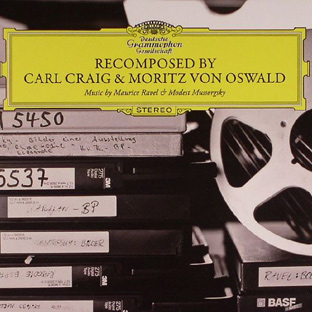Carl Craig & Moritz Von Oswald - Recomposed Vol 3
 Bleep43
Bleep43  Wednesday, October 29, 2008 at 04:48PM
Wednesday, October 29, 2008 at 04:48PM 


CARL CRAIG & MORITZ VON OSWALD - Recomposed Vol. 3 (Deutsche Grammophon)
When a record carries the logo of Deutsche Grammophon, it’s imbued with a certain sense of cultural weight. From Karajan to Solti, from Beethoven to Stockhausen, the label’s distinct place in the hierarchy of classical music is without doubt assured. And when you see the names of Carl Craig and Moritz Von Oswald on the front of a record, it almost begins to feel as if they have been accepted into the upper pantheon of music, albeit as remixers.
This is actually the 3rd in a series that began with Jimi Tenor remixing Steve Reich, and sees the duo take on a Deutsche Grammophon staple, Ravel’s “Bolero” and Modest Mussorgsky’s “Pictures at an Exhibition”, reworking a 1987 recording. “Spanish Rhapsody” from Ravel is also worked in at some point.
The two pieces are linked by their hypnotic qualities, which I suspect is why they were chosen to receive this particular treatment, but also because both composers were in a fragile state of mind when they wrote them. It was recently revealed that Maurice Ravel may have been suffering from a rare form of frontemporal dementia when he composed “Bolero”, a condition that predisposes sufferers towards repetition. Mussorgsky composed “Pictures” during the 1870’s whilst suffering from delirium caused by alcohlolism, brought on by the death of his friend Joseph Hartmann, whose pictures inspired the piece. It would be Maurice Ravel’s orchestral interpretation of Mussorgsky’s original piano score a few decades later that gave Mussorgsky’s piece the recognition that it deserved.
Neither piece is a stranger to being re-interpreted, as the likes of Tomita and Emerson, Lake and Palmer have attempted more traditional reworkings, which is why I suspect why both Craig and Von Oswald have steered clear of attempting to recreate them electronically in their entirety. For example, the traditional “Bolero” is dominated by an ostinato that is the recurring theme throughout the piece, providing it with a rhythmic force and sense of martial purpose that never goes away. This version eschews the splendour of the signature woodwind that make it such a drowsy and yet dramatic experience, and stretches out the score over a period of 31 minutes, nearly twice the length of the original. Yet whilst the standard soars to a crescendo that is amongst the most breathtaking in the classical reportoire, this one maintains a steady pace that is then accompanied by a plangent bass line and choral-style synths that are almost soporific in their atmosphere. By the time a techno rhythm kicks in, it’s as if there are very few motifs of the original theme left except for some low-lying melodic codas that are virtually invisible in the mix. The last 10 minutes seem to me like a freeform work-out between Craig and Von Oswald that hints at something great, but it’s as if neither of them is willing to take the lead. It’s a peculiar, if somewhat middle of the road ending to what appears to be an opportunity lost, although the final melodic piece is full of emotional warmth.
An ambient interlude links the two pieces, and for “Pictures at an Exhibition” they retain the haunting piano coda of the original whilst adding an uptempo beat early on, driving the hypnotic elements forwards with some force. Sampled strings weave in and out of the mix, and all of a sudden the tempo drops to a jazz lilt that Craig is comfortable with. Of the two, this feels by far the more experimental, although that may be because it is a more complex score despite retaining simple instrumentation. The narcotic throb of Von Oswald’s production comes to the fore here, as ambient pulses and bass mean that the piece is, ultimately, re-composed into something completely different.
Whilst one might have expected a veritable fireworks of sound in this collaboration, it says more about the subtle talents of both of them that neither dominate proceedings. Indeed, Von Oswald’s experienced ear suits the sound palette of both scores providing a warm, fuzzy tone to it, and if it wasn’t for the rather tame end to “Bolero” I would heap more praise upon this album. It’s often the case that reworkings of classical pieces end up being ostentatious nonsense, and to their credit both of them manage to avoid that route despite the dramatic feel of both scores.
Toby Frith
WATCH DANIEL BARENBOIM CONDUCT “BOLERO” WITH THE BERLIN PHILHARMONIC BELOW

Reader Comments